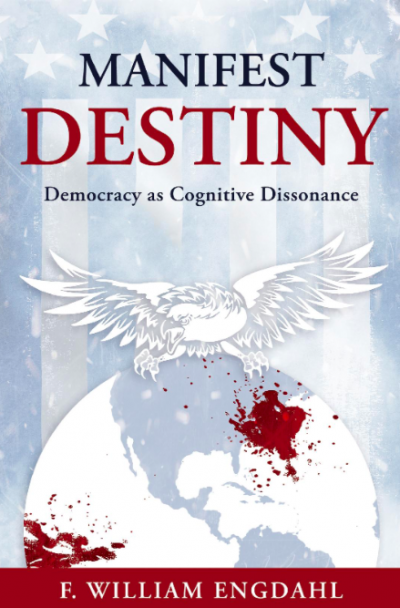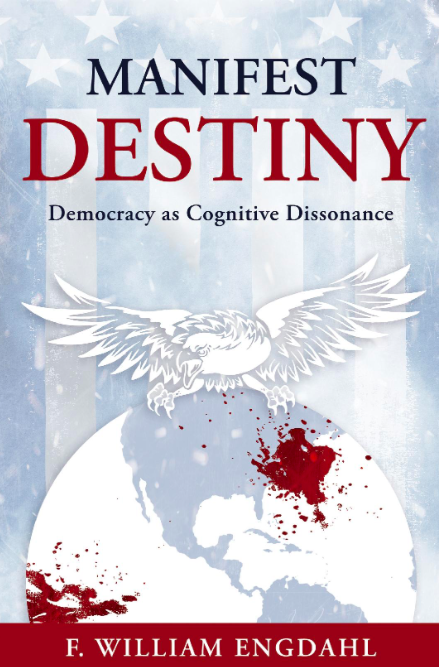Manifest Destiny and Orwell’s Doublethink: “Democracy as Cognitive Dissonance”
New Book

Note to readers: please click the share buttons above
Introduction
Freedom is Slavery: Destroying Nations in the Name of Democracy
In 1945, British writer and social critic George Orwell wrote a book titled 1984 on the theme of a fictional totalitarian society. The book, one of the most successful in publishing history, relates the aftermath of an atomic world war in which the world is partitioned into three states. One state, Oceania, whose capital is London, is ruled by an English Socialist Party that has total control over all its citizens, especially over their minds. The central mind-control program used to keep its citizens abject and obedient mind slaves was referred to as “doublethink.” In doublethink, subjects were submitted to two contradictory concepts, both of which they must accept as correct simultaneously, termed by psy-chologists “cognitive dissonance.” So, although Oceania is constantly at war, its citizens act as if there is peace too. The essence of the doublethink is summarized by Orwell at the beginning of the novel:
War is peace.
Freedom is slavery.
Ignorance is strength.1
In the following work I chronicle what, in truth, is an adaptation of Orwell’s doublethink which might be termed “democracy as cognitive dissonance.” It’s the chronicle of one of the most destructive and one of the most effective operations by the intelligence services of any modern state, including of that of Stalin’s Soviet Union or even Hitler’s Goebbels-steered Third Reich. It’s the chronicle of a vast project developed by US intelligence services over decades, going back to the May 1968 CIA student strikes that brought down French President Charles de Gaulle, a determined foe of American global domination.
The Cold War between the countries of NATO and those allied to the Soviet Union lasted nearly a half century. Finally, exhausted and economically in dire straits, the Soviet Union, under Mikhail Gorbachev, raised a white flag of surrender in November 1989, as Moscow let the Berlin Wall fall. The wall had become the symbol of what Winston Churchill, in his famous 1946 Fulton, Missouri–speech, called the Iron Curtain dividing the West–the “Free World” as Washington propaganda was fond of ever repeating–from the communist world dominated by Moscow.
Outside a small circle of US CIA, State Department, and Pentagon senior officials, together with their allies in select Washington think tanks, such as the American Enterprise Institute or the New York Council on Foreign Relations, what few realized was that Washington was about to unleash the most concerted effort at regime change across the former communist countries of Eastern Europe, Ukraine, and the newly formed Russian Federation itself. The rallying call was the “introduction of US-style democracy, freedom, human rights, a neo-liberal free market.” It was to become a tyranny and in some cases, such as Ukraine, it would be far worse than anything experienced under the Soviet regime.
The Washington regime-change operations came to be called “color revolutions” because of the distinct Madison Avenue color-logo themes each destabilization brought with it—the Orange Revolution in Ukraine, the Rose Revolution in Georgia, the Green Revolution in Iran, and so forth. Invariably, they targeted any significant nation that stood in the way of what David Rockefeller, in his Memoirs, referred to as a one-world government or Bill Clinton, in the 1990s, referred to by the innocent-sounding term but not-so-innocent process of corporate globalization.2
In truth, what those Washington color revolution regime-change inter-ventions represented was an attempt to replace former communist leaders with handpicked, Washington-corrupted political leaders who would be willing to sell their national crown jewels and their people to select Western financial predators, such as the billionaire speculator George Soros or Western bankers and multinational corporations.
The Aura of American Power
Ironically, the greatest challenge confronting Washington, the Pentagon, the CIA, and the powerful military–industrial and banking lobby groups, who control congressmen and presidents with their money, was the end of the active Cold War in late 1989. There was suddenly no “enemy” to justify continued vast US military spending or the existence of NATO.
James R. Schlesinger, former US defense secretary and later CIA director, described the dilemma:
“American policymakers should be quite clear in their own minds that the basis for determining US force structure and military expenditures in the future should not simply be the response to individual threats, but rather that which is needed to maintain the overall aura of American power.”3
At the end of the 1980s, the economy and financial system of the US was in the throes of its deepest crisis since the Great Depression. The larg-est banks of Wall Street—Citigroup, Bank of America, and others—were technically bankrupt. The deregulation of US Savings & Loan banks had led to a real estate speculation bubble that collapsed in the late 1980s, at the same time as a dramatic fall in world oil prices led to waves of bankruptcies across the US domestic oil industry.
To demand that US taxpayers continue to waste hundreds of billions of their tax dollars on high levels of defense spending for an enemy that could no longer be identified, rather than to create a “peace dividend” that would allow those billions to go to the renewal of America’s rapidly decaying economic infrastructure, was a challenge to the US military and intelligence establishment. Chairman of the Joint Chiefs of State Colin Powell told Army Times in April 1991:
“Think hard about it, I’m running out of demons. I’m running out of villains. . . I’m down to Castro and Kim Il Sung.”4
That dilemma was soon to be resolved. Rather than solely relying on military overt force to advance its global agenda, Washington unveiled a dramatic new weapon: “fake democracy” nongovernmental organizations (NGOs) that would be used to covertly create pro-Washington regimes in strategic parts of the world after the collapse of the Soviet Union. Democratic freedom would be the banner, incredibly enough, to introduce a new tyranny: “free” markets in actual fact controlled by Wall Street and European global banks, as well as Western multinational corporations that would loot the vast state-owned resources of the collapsed communist world.
Weaponizing Human Rights
Instead of overt military confrontation, the 1990s, with the brutal exception of Washington’s war in Yugoslavia, were to see the major deployment of what was becoming a dramatically effective new weapon for US-steered, fake democracy regime changes around the world.
So-called “human rights” NGOs, such as Human Rights Watch financed by billionaire speculator George Soros, Freedom House, the International Republican Institute (IRI), Amnesty International USA, or the US govern-ment’s supposedly private National Endowment for Democracy (NED), were to become a primary Washington weapon for regime change to transform the newly independent states of formerly communist Eastern Europe and Russia as well. Later, Washington’s “fake democracy” color revolutions would be brought to China, Central Asia, and, most dramatically, to the oil-rich states of the Middle East as the so-called Arab Spring.
The goal was to turn the target countries into US economic satrapies, or vassal states, by way of a series of regime-change color revolutions. It took a while before the unsuspecting target nations realized what was being done to them and their economies in the name of US export of “democracy.”
The first successful fake democracy color revolution regime change was aimed at Slobodan Milošević, then president of what had become by 1999 former Yugoslavia—Serbia, Vojvodina, Kosovo, and Montenegro.
We begin our investigation with a description of the birth of the NGO in Washington that was created with little fanfare by President Reagan’s CIA Director Bill Casey and others in the early 1980s. It was called the NED or National Endowment for Democracy. That NED has played the central role in every Washington-backed regime destabilization aimed at governments pursuing policies not congruent with those of Washington’s post–Cold War new globalization order.
*
F. William Engdahl is strategic risk consultant and lecturer, he holds a degree in politics from Princeton University and is a best-selling author on oil and geopolitics. He is a frequent contributor to Global Research.
Notes
1. George Orwell, 1984, cited in https://www.brainyquote.com/quotes/quotes/g/georgeorwe141783.html
2. David Rockefeller, Memoirs, p. 405, http://opengov.ideascale.com/a/dtd/David-Rockefeller-s-book-Memoirs-admits-secretly-conspiring-for-a-NWO/4007-4049. The quote reads: “Some even believe we [Rockefeller family] are part of a secret cabal working against the best interests of the United States, characterizing my family and me as ‘internationalists’ and of conspiring with others around the world to build a more integrated global political and economic structure – One World, if you will. If that’s the charge, I stand guilty, and I am proud of it.”
3. Joe Stork, New Enemies for a New World Order, MER176, http://www.merip.org/mer/mer176/new-enemies-new-world-order?ip_login_no_cache=e4b-596febb56c8ddb4c739f2806fd833.
4. William W. Kaufmann and John D. Steinbruner, Decisions for Defense (Washington, DC: Brookings Institution, 1991), p. 45.
The original source of this article is Global Research
Copyright © F. William Engdahl, Global Research, 2018


No comments:
Post a Comment
Note: Only a member of this blog may post a comment.